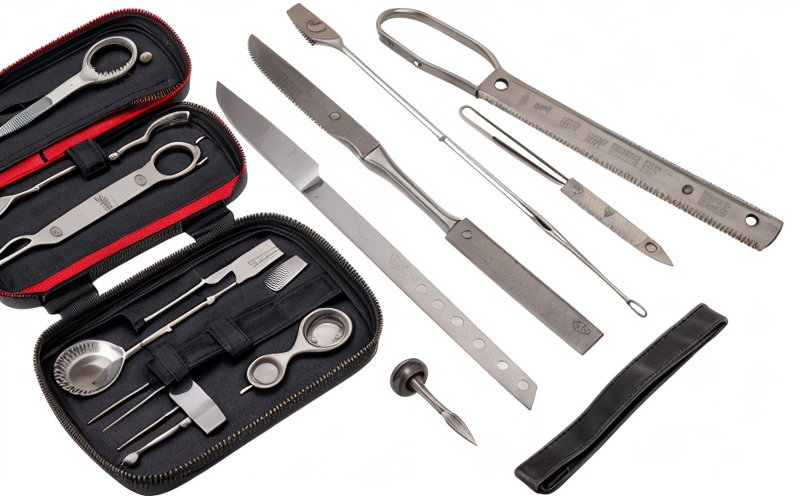Cold Resistance Testing for Low Temperature Sterilization Compatibility
The demand for medical devices that can withstand harsh environmental conditions is growing. One such critical requirement is ensuring compatibility with low temperature sterilization processes, particularly in cold resistance testing. This service is aimed at manufacturers and quality managers seeking to ensure their surgical instruments and tools meet stringent standards before they reach the market.
Low temperature sterilization methods like Ethylene Oxide (EO) or Sterilizing Grade Hydrogen Peroxide Vapor (HHP), are widely used in the medical industry for their effectiveness in killing microorganisms. However, these processes can be extremely stressful on materials and devices, leading to potential structural changes or reduced functionality. Ensuring that surgical instruments maintain their integrity through cold resistance testing is crucial.
Our service focuses on evaluating how well surgical instruments and tools withstand cold sterilization conditions, ensuring they remain safe and effective post-sterilization. This involves testing the materials under controlled cold conditions to simulate real-world scenarios where these devices might be used in low temperature environments such as cryotherapy or arctic conditions.
The process of cold resistance testing is intricate and requires a detailed understanding of material properties, design considerations, and sterilization processes. It starts with selecting the appropriate specimens for testing, which are typically representative samples from batches produced under standard operating procedures (SOPs).
Testing apparatuses used in this service include specialized chambers that can simulate low temperatures relevant to the expected use conditions. These chambers are equipped with sensors to monitor temperature and other environmental parameters precisely. The specimens are subjected to these controlled cold environments, often for extended periods, to evaluate their resistance.
The acceptance criteria for passing this test are based on international standards such as ISO 11135-2:2016, which provides guidelines for determining the effectiveness of sterilization processes and ensuring that devices remain functional after being exposed to these conditions. Compliance with these standards is critical not only for regulatory compliance but also for maintaining product quality.
Our team of experts ensures that every aspect of this testing process adheres strictly to these international guidelines, providing reliable data that can be used to make informed decisions about design modifications or production adjustments if necessary. By partnering with us, you gain access to cutting-edge facilities and experienced professionals who understand the nuances of medical device development.
Through rigorous cold resistance testing, we help ensure your surgical instruments are not only safe but also reliable in their intended applications. This service plays a vital role in safeguarding patient safety by confirming that devices continue to function optimally after exposure to low temperature sterilization processes.
- Enhanced Patient Safety: Ensures devices remain effective and free from degradation post-sterilization.
- Regulatory Compliance: Meets international standards like ISO 11135-2:2016 for sterilization effectiveness.
- Improved Device Functionality: Identifies any potential issues early in the development process, preventing costly recalls later on.
- Enhanced Brand Reputation: Demonstrates commitment to quality and patient safety through rigorous testing protocols.
In conclusion, cold resistance testing is an essential step in ensuring that surgical instruments are both safe and effective. By partnering with our team of experts, you can ensure your products meet the highest standards, thereby protecting patients and maintaining a strong brand reputation.
Scope and Methodology
The scope of cold resistance testing for low temperature sterilization compatibility includes evaluating materials and devices under controlled cold conditions to simulate real-world stressors encountered during sterilization processes. This service ensures that surgical instruments maintain their integrity, functionality, and safety after exposure to these harsh environments.
Our methodology involves a series of steps designed to accurately assess the performance of surgical instruments in cold resistance testing. Initially, we select representative specimens from batches produced under standard operating procedures (SOPs). These specimens undergo rigorous testing using specialized chambers capable of simulating low temperatures relevant to expected use conditions.
The temperature and other environmental parameters within these chambers are closely monitored by sensors to ensure precise control during the test. Specimens may be subjected to cold environments for extended periods, allowing us to evaluate their resistance comprehensively. Acceptance criteria based on international standards such as ISO 11135-2:2016 guide this evaluation process.
Our team of experts ensures that every aspect of the testing adheres strictly to these guidelines, providing reliable data for informed decision-making regarding design modifications or production adjustments if necessary. By following this meticulous approach, we help ensure your products meet stringent quality and safety standards.





